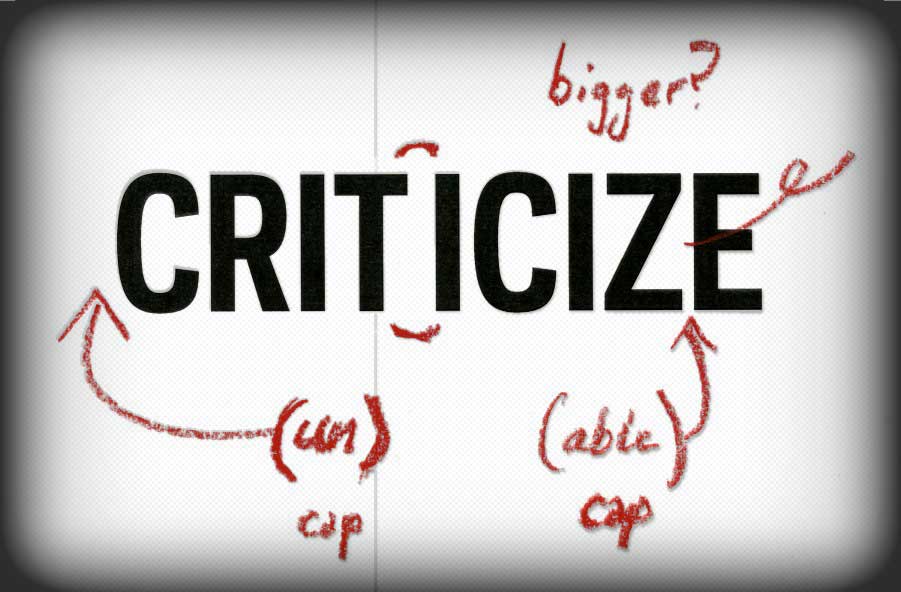
Critiquing and Criticizing. They’re not the same thing.
“We critique far too soon, we must first seek understanding.” – Marshal McLuhan
I come from the art world. Critiquing is something I do often so I’m very familiar with the term. However, lately I’ve been reading a lot of theoretical, academic essays dealing with the “critique” of various theological/philosophical/sociological ideas and/or movements. I’m finding that, although the word “critique” is thrown around a lot, there obviously is a different definition being employed in academia for the word other than the one I’m used to. In other words, I’ve noticed that a lot of this academic style analysis I’ve been reading really seems to be criticism masquerading as critique.
In design school critiquing was the primary way we were taught, and was by far the best way for us to learn. Two things were made abundantly clear to students right up front:
- We critique, we do NOT criticize
- One method is used to edify, the other is used to destroy
Critique and criticism are often conflated, as they both can essentially be defined as an assessment, appraisal or evaluation of something. However, it’s obvious to most that these two methods of evaluation come from different places. As stated above, the purpose of the critique is to improve upon something by testing for weaknesses. Critique should be objective, honest and useful, the end goal being excellence. Criticism comes from a place of subjectivity and is based on disapproval of perceived (or per-conceived) or obvious faults and shortcomings. The critic’s intent is to tear something down, and most criticism does tend toward negativity. In design school we were instructed on how to critique. We were instructed to be precise with our language, because if design was meant to be purposeful, and not whimsical, critique of design should also be purposeful and not based on personal opinion. Over the years I have found that I can tell rather easily if I’m receiving criticism, and not critique, because the evaluation will actually tell me a lot more about the person giving the assessment than it does about the piece which is being assessed. Here is how I have learned to critique over the years:
Look through the eyes of the other – If you’re going to be critiquing another person’s work it helps to know where they’re coming from; the person who is critiquing is seeking understanding. The analogy I like is this: How can a writer write about something she doesn’t know about? Get to know the person you’re critiquing and their work. If it’s an artist, don’t just look at one or two of their paintings. Ask the artist questions, and have them explain things to you, decisions they’ve made. Critique is about teaching and learning. It’s not about making unverified assumptions.
Be as neutral as possible – A persons work usually has an objective or a goal. In my case, design, the work always has a purpose. For a critique to be neutral it should be based on established objective guidelines. For instance, does it function aesthetically as a good design? Are color, balance, rhythm, harmony, spatial relationships and value all working together to accomplish the intended outcome?Asking questions like these helps the critique to stay objective and avoids the realm of subjective value judgement. “I think this is a good design because it makes me feel…” is not objective criteria and thus is not the best way to critique.
Start positive and end positive – I was always taught to critique this way, and I think it’s spot on. Even if it’s difficult, find something nice to say first. After that, be as honest as possible, without being mean.
Remember, honesty without grace is just brutality.
Close with another encouraging positive statement. This shows that you understand how important someone’s work can be to them. The work we all produce comes from within and many times people cannot separate themselves from their work, therefore any type of negative assessment can become a personal attack. Closing on a positive note shows understanding of this and conveys a constructive message.
To be honest, I think criticism and critique both have their place. Sometimes we need to deconstruct things. Sometimes things just don’t work. There are a lot of bad ideas out there, for sure. It would be wrong to try to just critique (build up) something that is causing pain or oppression, i.e. a malevolent political regime for instance, deserves heavy negative criticism. I think, however, it’s helpful to know which one you’re doing at any given time because, again, which one you choose to do says a lot about who you are and, ultimately, may end up sending a subliminal, yet revealing, sub-text. Negatively criticizing can be really easy and feel really good. I’ve found that it’s extremely easy to gripe and point out faults, but being helpful and edifying is not so easy. It takes more time and requires one to be considerate and thoughtful, but I’ve often heard that teaching is the best way to learn.
So, next time, before critiquing or criticizing, ask yourself: what’s my goal here? Am I trying to help this person or hurt them? Am I building up or tearing down? Is this whole analysis about the work, or is it really about me? For me there is a certain satisfaction gained from giving someone a good critique, a satisfaction that you don’t get from negatively criticizing. Knowing I have helped someone on their way by participating in a mutual act of humility and pedagogy is an unmatched joy, and negative criticism alone, for me, has become boring. But hey, this method is of course open for critique.
…
A follow-up post on the importance of criticism is here: http://turri.me/?p=138

0 Comments